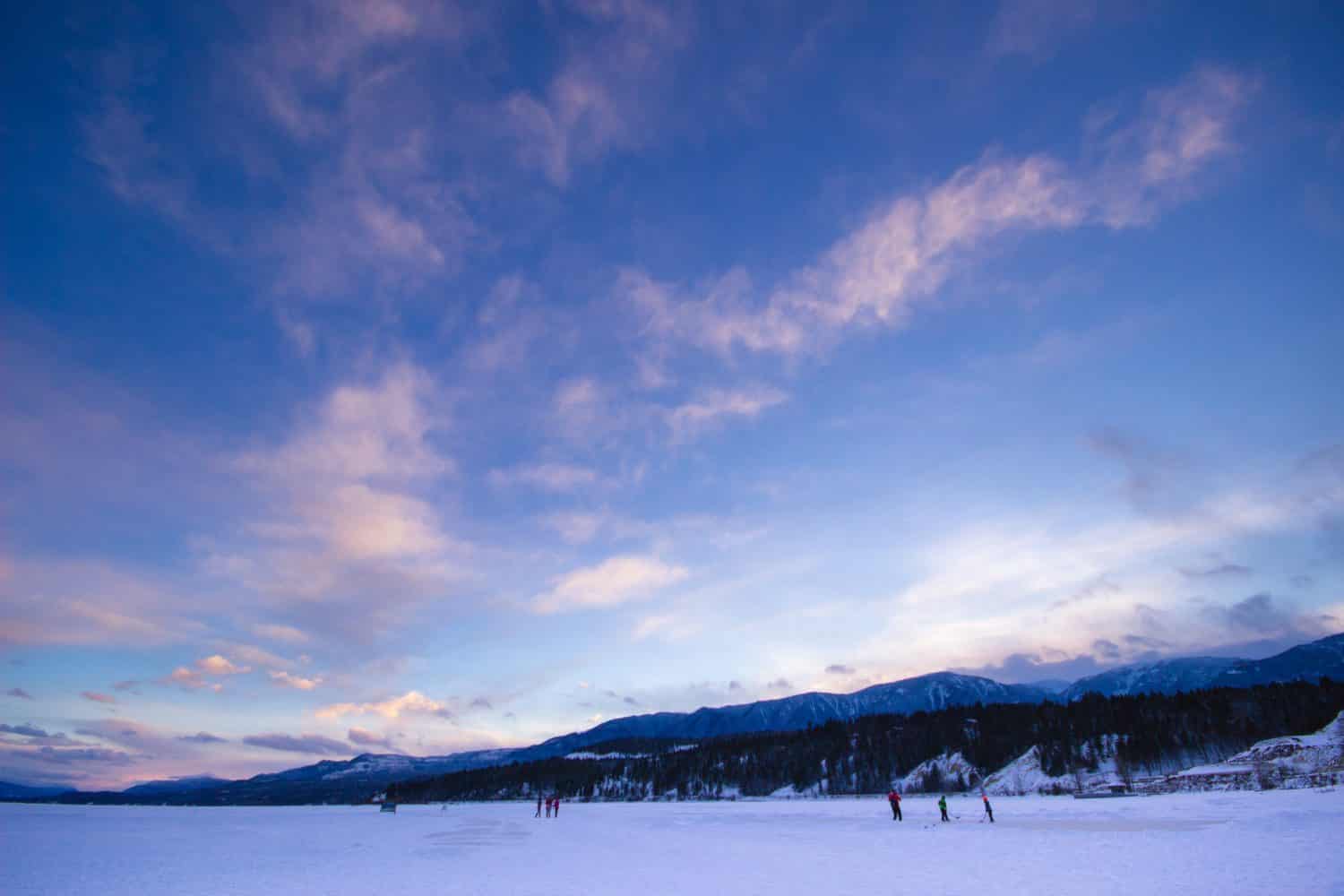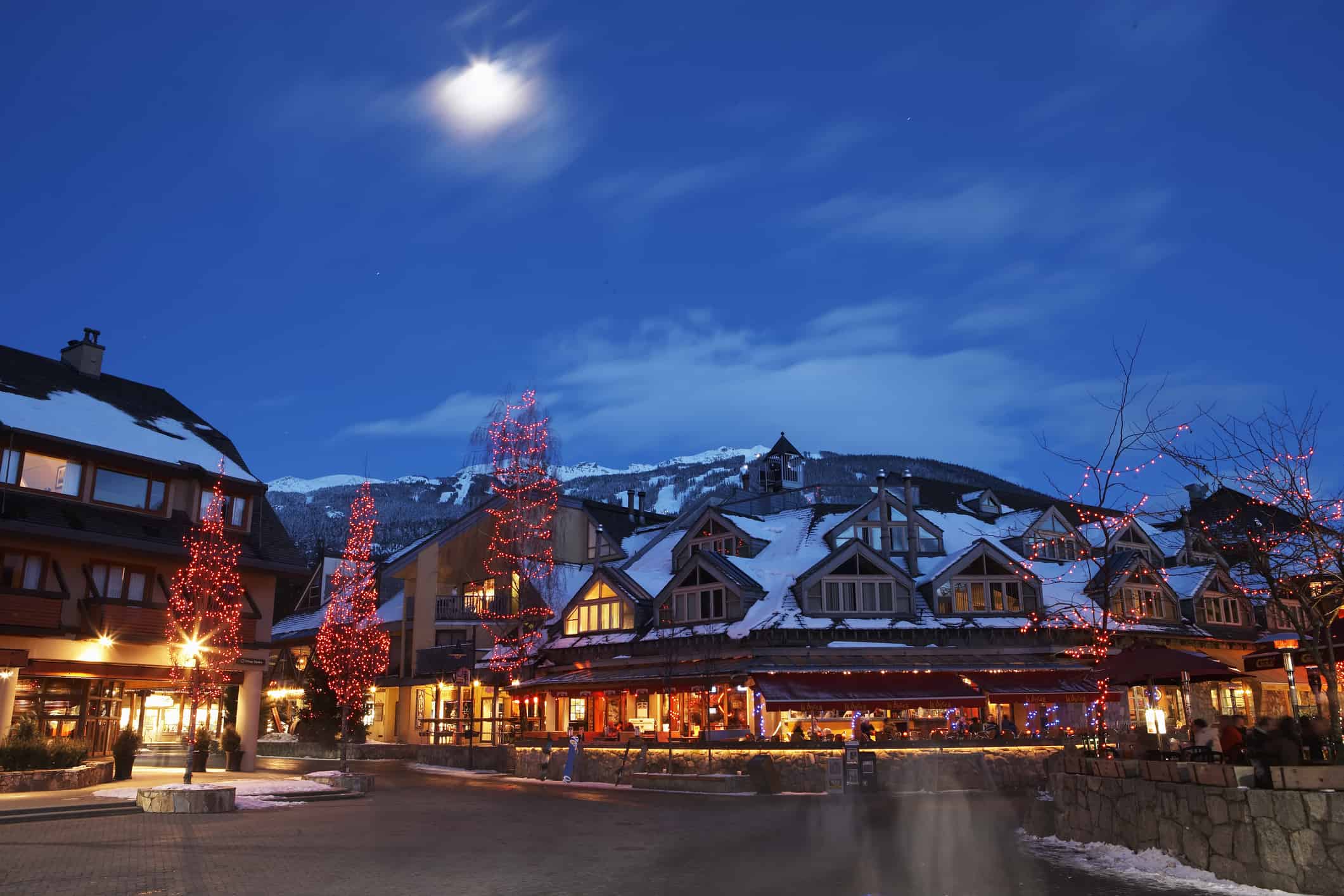British Columbia is the westernmost province of Canada. Here you will find large areas of protected green space and thousands of miles of coastlines. Victoria on Vancouver Island is its capital city and the province’s population is around 5.5 million as of 2023 in an area of 364,764 mi². It boasts the country’s largest fishing industry and considerable dairy and cattle farming. On the eastern border are the province of Alberta and the Rocky Mountains. The Yukon and Northern Territories are to the north and the Pacific Ocean is to the west with the United States in the south.
The geography is unlike the rest of Canada. Known as the Cordillera region it has long rivers, deep valleys, and vast, forested mountain ranges with much of the Rocky Mountains. Indeed, the area is breathtaking and in the winter a wonderland! Continue reading to find out more about the four lakes in British Columbia that completely freeze over in the winter and how to enjoy them!
Emerald Lake in Yoho National Park

Glacial melt flows into the lake carrying fine particles that disperse sunlight creating beautiful hues.
©Pongsakorn Teeraparpwong/Shutterstock.com
Emerald Lake in Yoho National Park is a freshwater lake on the boundary of Alberta and British Columbia in the heart of the Canadian Rockies. It is one of four contiguous National Parks, the other three being Jasper, Banff, and Kootenay, and has an area of 225 acres at 4,267 feet above sea level. Canadian guide Tom Wilson named it in 1882 for its beautiful color. This occurs because glacial silt is carried by glacial melt that flows into the lake. As a result, the fine particles disperse sunlight creating beautiful hues. Additionally, Wapta Mountain and Mount Burgess provide a stunning backdrop. During the winter the lake completely freezes over and stays frozen from November until early June. People come here to enjoy winter sports such as ice skating, when snow is not abundant on the lake. Even more, backcountry skiing and snowshoeing are popular sports.
Emerald Lake Lodge dates to 1902. It was built by the Canadian Pacific Railway. Today they rent 24 cabins, there is an outdoor hot tub, two restaurants, canoe and kayak rentals, and a gift shop. The nearest town of Field is 15 minutes away. Banff is over an hour away, and Lake Louise is a 30-minute drive. A pass is needed to visit Yoho National Park which can be purchased at the entrance gate or online from Parks Canada. Wildlife in the area includes mergansers, loons, ospreys, moose, and bald eagles. Additionally, there are beavers, black bears, big-horned sheep, and rainbow and brook trout. Since there is no cell signal here unplug and enjoy the majesty of this incredible place!
Columbia Lake

Columbia Lake is the primary lake at the headwaters of the Columbia River in British Columbia.
©iStock.com/JPLDesigns
Near the town of Canal Flats, Columbia Lake has a long history stretching back 10,000 years when the Ktunaxa people lived here. It wasn’t until the 1800s that the first Europeans arrived. The lake freezes in the winter, and as a result, it is a favorite spot for ice boat racing and ice fishing. It is the primary lake at the headwaters of the Columbia River and is fed by small tributaries. The average depth is 19 feet with an area of 9.923 mi² and the surface elevation is 2,651 feet above sea level. Typical freezing months are December until March.
The lake was named after the Columbia River, the largest in the Pacific Northwest in North America by American sea captain Robert Gray navigated the waters in 1792 trading fur pelts. Canal Flats or Radium Hot Springs access the lake along Highway 93 and 95 and from Montana in the U.S. on the same highway. Radium Hot Springs is indeed a working hot spring where during the winter one can defrost in the hot pools.
Wetlands, grasslands, and marshes offer many opportunities for observing nature. There are abundant insect, mammal, reptile, and avian species here. Several are endangered such as the badger, Rocky Mountain bighorn sheep, and the great blue heron. Additionally, it is a migratory route for waterfowl and includes such species as Canada geese, tundra swans, osprey, and bald eagles. The lake is largely pristine therefore it offers prime grazing for mule deer and elk. Indeed, fishing is a popular sport here where such species as cutthroat, bull and rainbow trout, burbot, and mountain whitefish are abundant.
Lake Windermere

This naturally frozen lake features the 2014 Guinness World Record-winning longest ice-skating trail.
©Globe Guide Media Inc/Shutterstock.com
This naturally frozen lake features the 2014 Guinness World Record-winning longest ice-skating trail coming in at 18 miles. Indeed, an ice skater’s paradise! The groomed trail runs around the lake and a day pass requires a $5 donation per person. The lake freezes four months out of the year. Sourced from the Columbia River it has an average depth of 15 feet, is 6.216 mi² in area, and is 2,618 feet above sea level.
The nearest town of Windermere is a half mile east of the lake, named for its namesake in the Lake District of England. Additionally, there is cross-country skiing, ice hockey, and ice fishing. Nearby Reel Axe Adventures out of Radium Hot Springs offers “lux” ice fishing huts. They include all equipment, a fire and grill to cook your catch, and guides if needed. Indeed, they even supply transportation!
Wildlife here includes elk, mule deer, and white-tail deer who graze during the winter months. Birdwatchers enjoy peregrine falcon, red kite, and tufted and goldeneye duck. Fish species include sea trout, salmon, eels, roach, perch, pike, brown trout, and local favorite Arctic char. When visiting, remember that motorized vehicles are prohibited making this place a quiet respite from busy modern life. As a result, the only thing you are apt to hear are ice skates carving through ice!
Alta Lake

Whistler was originally named Alta Lake but settlers renamed it after hearing the shrill whistle of the local western hoary marmots.
©Thomas Northcut/DigitalVision via Getty Images
The largest of the five lakes at Whistler, which include Alpha, Nita, Alta, Lost, and Green Lake is accessible along Highway 99. Along the lake is the Valley Trail, a 28-mile path that connects all the lakes and prohibits motor vehicles. Located in the municipality of Whistler, Alta is Spanish for “upper” or “high up.” The elevation here is 2,106 feet above sea level on 272 acres with a length of 1.367 miles. In 1900 prospectors and trappers settled here. Alta Lake was the original name of Whistler. Settlers renamed it after hearing the shrill whistle of the local western hoary marmots that live in nearby rocks.
From November until April, the lake is frozen. As a result, winter activities here include cross-country skiing, snowshoeing, sleigh rides, wind skiing, ice hockey, and ice stock sliding. Wildlife in the area includes black bears, deer, beaver, minks, chipmunks, and squirrels. Additionally, there is a diverse bird population here due to the wetlands that run between Green Lake and Alta Lake. As a result, grey and blue herons, ravens, owls, red-tailed hawks, osprey, and bald eagles call this home. Smaller birds include woodpeckers, finches, chickadees, robins, and grackles. Lake creatures include minnows, trout, perch, and sunfish. In addition, it is where a large tadpole spawn occurs when the frog and toads migrate.
Four Lakes in British Columbia that Completely Freeze Over in the Winter
| Name | Size |
|---|---|
| Emerald Lake in Yoho National Park | 225 acres |
| Columbia Lake | 9.923 mi² |
| Lake Windermere | 6.216 mi² |
| Alta Lake | 272 acres |
The photo featured at the top of this post is © iStock.com/Leamus
Thank you for reading! Have some feedback for us? Contact the AZ Animals editorial team.







